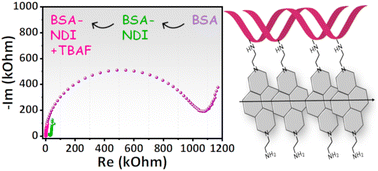Mixed ionic–electronic conductance across naphthalenediimide-functionalized biopolymers†
Abstract
Mixed ionic–electronic conductive polymers are gaining high momentum for several electronic and bioelectronic applications. These polymers are composed of a synthetic conjugated polymer for electronic conduction and a synthetic ionomer for the ionic one. To make these materials more environmentally sustainable, much effort is being put in replacing synthetic polymers with biopolymers. However, to date, the only strategy for making mixed conductors with biopolymers is to blend them with synthetic polymers. Here, we show that by targeting certain amino acids of a protein-based biopolymer, we can modify them with naphthalenediimide (NDI) after polymerization, resulting in an improved electronic transport, which is in addition to the native ionic transport of the biopolymer. We further show that by reducing the NDI moieties we can reach conductivity values in the order of 40 mS cm−1, though NDI can re-oxidize depending on the environment of the biopolymer. The abundant nature of the protein building blocks together with the easy post-polymerization functionalization chemistry of NDI, which is very much different than any previous use of NDI in conductive polymers, is making our new strategy for making mixed ionic–electronic conductive biopolymers highly attractive.



 Please wait while we load your content...
Please wait while we load your content...